The Gb Major chord, often referred to as the G flat Major chord, is a fundamental chord in guitar playing and music theory. Interestingly, it’s enharmonically equivalent to the F# Major chord, meaning they sound the same but are written differently depending on the musical context. The most common way to tackle the Gb chord on guitar is using a root 6 barre chord starting at the 2nd fret. One key characteristic of the Gb chord is that it cannot be played as an open chord because none of its constituent notes are available on open strings.
Delving into the Theory of the Gb Chord
To truly understand the Gb Major chord, let’s explore some essential music theory:
- Chord Notes: The Gb Major chord is built from three notes: Gb, Bb, and Db.
- Scale Derivation: This chord is formed by playing the 1st (root), 3rd, and 5th degrees of the Gb Major scale. Understanding scales is crucial for grasping chord construction.
- Interval Composition: Like all Major chords, the Gb Major chord is defined by specific intervals from its root note: a Major 3rd, followed by a minor 3rd, and a Perfect 4th to return to the root in the next octave.
- Key Significance: The Gb chord holds the prestigious position of being the first chord (the tonic chord) in the key of G flat Major. The complete set of seven chords in the key of Gb Major includes: Gb, Abm, Bbm, Cb, Db, Ebm, and F diminished.
10 Essential Ways to Play the Gb Major Chord
For guitarists eager to visualize and play the Gb chord, here are 10 different shapes presented in chord diagrams:
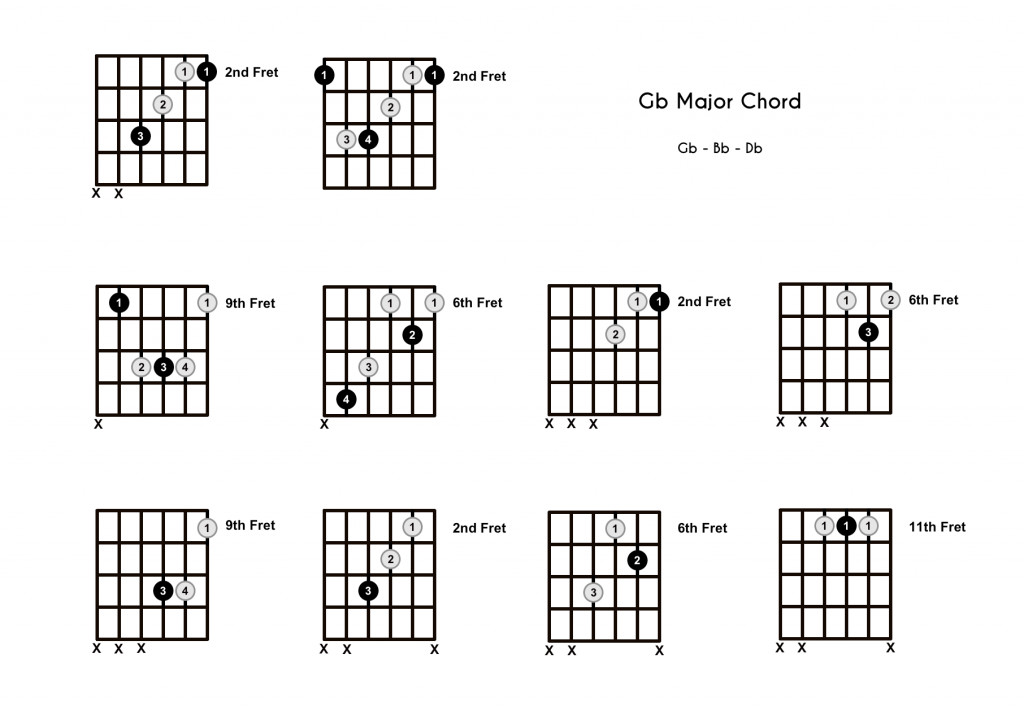 Diagram showing 10 different shapes for playing the Gb Major chord on guitar
Diagram showing 10 different shapes for playing the Gb Major chord on guitar
The Standard Gb Chord Shape: Root 6 Barre Chord
The most frequently used method for playing the Gb chord is the root-6 barre chord shape. This involves barring across the fretboard and is typically positioned starting at the 2nd fret.
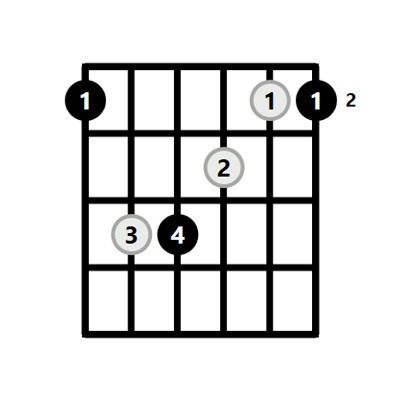 Diagram illustrating the standard Gb Chord Guitar shape, a root 6 barre chord on the 2nd fret
Diagram illustrating the standard Gb Chord Guitar shape, a root 6 barre chord on the 2nd fret
The Easier Gb Chord Shape for Beginners
While the root-6 barre chord is the standard, a simplified version of the Gb chord can be very beneficial, especially for guitarists just starting their chord journey. This “Easy Gb” shape uses just three strings and requires only the first three fingers.
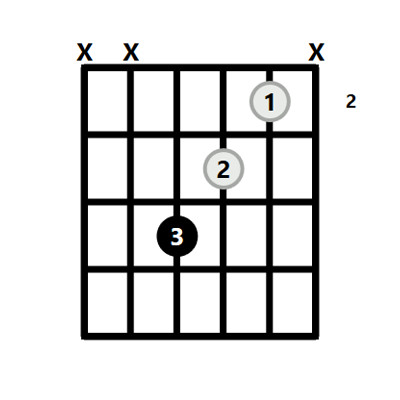 Diagram depicting the Easy Gb Chord Guitar shape, a simplified three-string version for beginners
Diagram depicting the Easy Gb Chord Guitar shape, a simplified three-string version for beginners
Step-by-Step Guide: How to Play the G Flat Major Chord (Standard Shape)
Let’s break down the standard Gb Major chord shape into easy-to-follow steps:
- Barre: Place your index finger across all six strings at the 2nd fret. Ensure you are applying enough pressure for each string to ring clearly.
- Third Finger: Position your ring finger on the 4th fret of the 5th string.
- Fourth Finger: Place your pinky finger on the 4th fret of the 4th string.
- Second Finger: Place your middle finger on the 3rd fret of the 3rd string.
- Strum: Strum all six strings from the low E string downwards.
These step-by-step instructions are particularly helpful for beginners or anyone who wants to double-check their finger placement for the standard Gb chord shape. By meticulously following these steps, you can ensure you are playing the chord accurately.
Utilizing Barre Chord Shapes for Gb Major
The Gb chord is ideally suited to be played as a barre chord. You can use both the root 6 barre chord shape (starting on the 2nd fret) and the root 5 barre chord Major shape (starting on the 9th fret) to create different voicings and positions for the Gb chord across the fretboard.
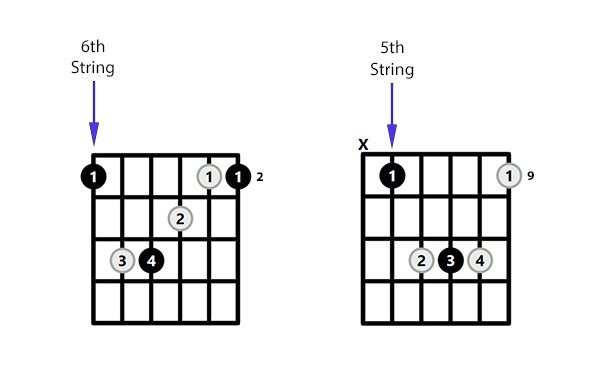 Diagram showing Gb Barre Chord Guitar shapes, including root 6 and root 5 variations
Diagram showing Gb Barre Chord Guitar shapes, including root 6 and root 5 variations
Exploring Gb Major Triads and Inversions
Beyond barre chords, understanding triads and their inversions expands your musical vocabulary. A Gb Major triad, in its fundamental form, consists of Gb, Bb, and Db. However, these notes can be arranged in different orders, known as inversions, to create varied sonic textures:
- Root Position: Gb – Bb – Db (Root note as the lowest note)
- 1st Inversion: Bb – Db – Gb (3rd of the chord as the lowest note)
- 2nd Inversion: Db – Gb – Bb (5th of the chord as the lowest note)
Here are visual representations of six different ways to play Gb Major triads, incorporating these inversions:
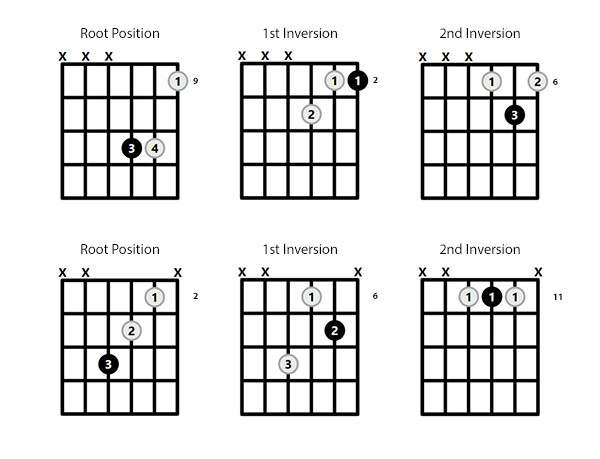 Diagram illustrating Gb Major Triad Guitar shapes, showing root position and inversions
Diagram illustrating Gb Major Triad Guitar shapes, showing root position and inversions
Musical Keys Where the Gb Chord Resides
The Gb chord naturally appears in several musical keys, making it a versatile chord in various musical contexts:
- Gb Major: (Gb, Abm, Bbm, Cb, Db, Ebm, Fdim) – As the tonic chord.
- Db Major: (Db, Ebm, Fm, Gb, Ab, Bbm, Cdim) – As the IV chord.
- Eb minor: (Eb, Fdim, Gb, Abm, Bbm, Cb, Db) – As the Major III chord.
- Bb minor: (Bbm, Cdim, Db, Ebm, Fm, Gb, Ab) – As the Major VI chord.
- Ab minor: (Abm, Bbdim, Cb, Dbm, Ebm, Fb, Gb) – As the Major VII chord.
Useful Alternative G Flat Chord Shapes
While the standard and barre chord shapes are common, exploring alternative shapes can add variety to your playing and potentially offer easier fingerings in certain musical passages. These shapes might not be as frequently used, but they are valuable additions to your Gb chord arsenal.
Gb Chord Substitutions and Related Chords
The Gb chord can often be interchanged with related chords to create harmonic variations and interesting chord progressions. Consider these substitutions:
- Gb sus4, Gb sus2, Gb add9: These suspended and added note chords offer subtle variations on the Gb Major sound.
- Gb Major 7, Eb7, and other Gb-rooted extension chords: While Gb Major can’t replace minor chords, it can often substitute more complex chords built on the Gb root, adding harmonic richness.
Scales to Solo and Improvise Over the Gb Chord
To effectively solo or improvise over the Gb Major chord, or to write melodies that complement it, certain scales are particularly well-suited:
(This section would typically list scales, but the original article ends abruptly here. For a complete article, scales like Gb Major scale, Gb Mixolydian, Gb Lydian, and potentially the blues scale in Gb could be mentioned and briefly explained.)
Further Exploration
[
